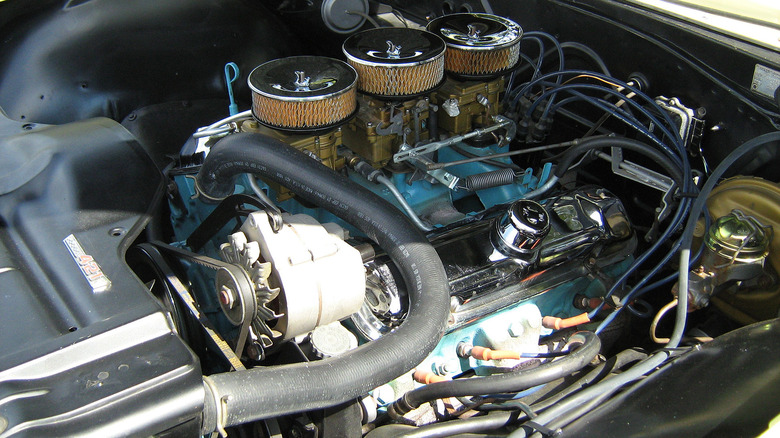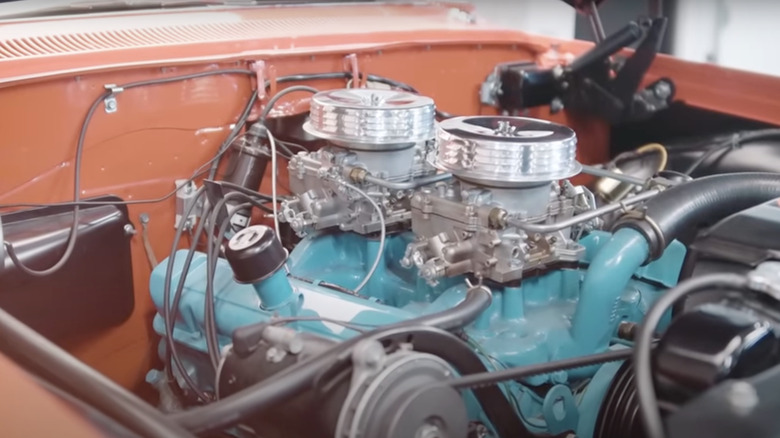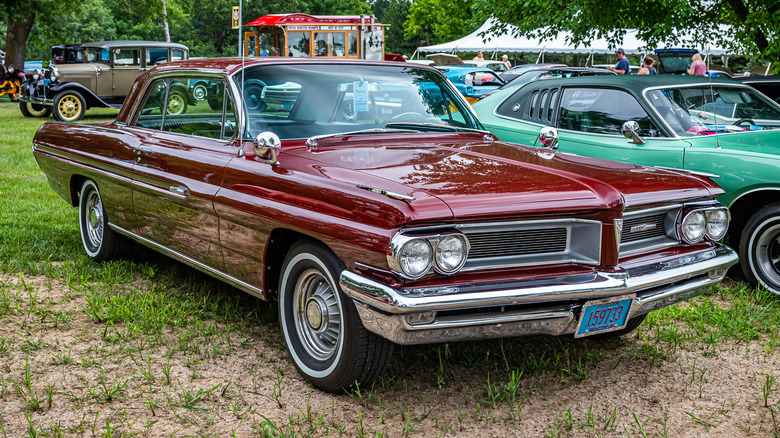Here's What Made The Pontiac 421 Super Duty Engine So Impressive
Pontiac made more than its share of classic muscle cars during the brand's run from 1926 through 2009, including the classic GTO. Two Pontiac badges that don't often get listed with the GTO, Firebird, and Trans Am in discussions of the brand's most powerful models are the Catalina and the Ventura. For a few years, however, those two cars were outfitted with one of the beastliest engines in automotive history.
In 1961, the super stock drag racing category was crowded with 400-plus cubic inch Chevys, Fords, and the newly introduced Dodge 413 Max Wedge. At the time, Pontiac's largest engine was a 389 cubic inch V8. Just prior to the NHRA U.S. Nationals on Labor Day Weekend in 1961, however, the automaker made the following announcement (via NHRA): "Pontiac is now offering to qualified drivers a 421 cubic inch high-performance engine option. The 421 engine is available only with related heavy-duty driveline components. It can be fitted to any Catalina or Ventura 2-door model."
The Super Duty 421 dominated NASCAR in 1962
The 421 actually made its racetrack debut a few weeks earlier, when Hayden Proffitt drove a 421-equipped Pontiac to a win at the Pomona Valley Timing Association's Top Stock championship. The Super Duty 421 landed under the broad hoods of the Catalina and Ventura in 1962, with a forged steel crankshaft and connecting rods and forged aluminum pistons. It shared its cylinder heads with the 389 Super Duty V8, and was topped with two Carter four-barrel carburetors. The 421 was officially rated at 405 horsepower, but a Motor Trend road test found the engine's output to be around 60hp more than that. In a nod to numerical symmetry, Pontiac only built 421 Catalinas with the 421 Super Duty engine in 1962, but the brand dominated the NASCAR circuit that year.
Glenn "Fireball" Roberts won the Daytona 500 with a Pontiac 421. Joe Weatherly won nine Grand National Series races and scored 39 top five finishes in 52 runs en route to a championship win in 1962. For 1963, Pontiac boosted the compression ratio from 11.0:1 to 12.0:1, increasing the redline to 6,400 rpm.
The Catalina was also lightened by using aluminum in some front-end components and drilling holes in the frame. The 1963 Catalina with the Super Duty 421 could go from 0-60 mph in 5.3 seconds, a full 7/10 of a second faster than that year's Chevy Corvette.
Is the 421 Super Duty a big block engine?
The Pontiac 421 Super Duty is certainly a very large engine, at least in dimensions. However, it does not classify as a traditional "big block" engine like the Chevy 454 or Chrysler 440 for a number of reasons. Perhaps the most important piece of information to consider is that Pontiac didn't classify their engines as big blocks or small blocks. SlashGear has reported on this nomenclature discrepancy.
Additionally, even if Pontiac decided to name its engines like everyone else, the 421 wouldn't fit the bill either. The engine itself is a bored-out version of the smaller displacement Pontiac 389 cubic-inch engine, making it a different animal altogether than other "big block" engines. It may have a large displacement of about 6.9 liters, but its architecture is still the same as the 389. Even with that, it's not worse than other engines that are rightfully called "big blocks" as the Pontiac powerplant is certainly capable of pumping out a lot of power.


